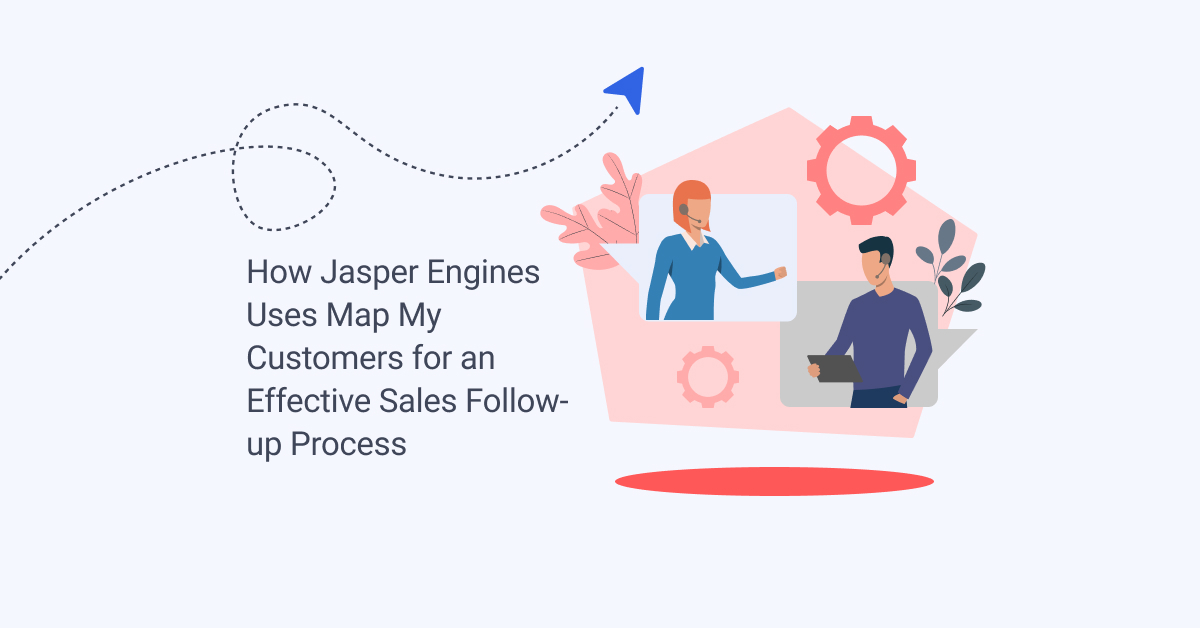
The success of your team’s sales efforts is directly impacted by how effective their sales follow-up process is. Deals rarely close in the first interaction. As a matter of fact, according to MarketingDonut, 80% of sales require at least 5 follow-up calls after the initial meeting and 44% of sales reps give up after 1 follow-up.
As Map My Customers’ Senior Enterprise Account Executive JT Rimbey describes, “a glaring weakness, specifically with outside field sales leadership, is a lack of process.”
You don’t want your reps to be part of that 44% statistic above. So, implementing a process that keeps your reps persistent, staying on top of follow-ups properly, and following a good sales cadence are critical pieces of the puzzle for high-performing sales teams.
With this type of consistency, one of the things that happen is that your customers realize they can count on your reps and this consistency drives loyalty.
But you may be wondering, what is the best way to create that follow-up process?
Implementing an Effective Sales Follow-Up Process
Joe McDonald, the Vice President of Sales at Jasper Engines & Transmissions, attributes much of the continued success of their sales team to a repeatable and consistent follow-up process that is built into their overall sales process.
McDonald understands that effective follow-up is a foundational building block that is necessary to set his reps up for success, close more deals, and elevate customer relationships.
So when it comes to sales follow-up best practices and creating an effective and organized follow-up process, it’s a two-part strategy:
Create “Buckets”
Firstly, you want to create groups or “buckets” of similar accounts. This is based on things like their potential revenue (for prospective customers), the type of company, their industry, their typical spend with your company (for existing customers), or the products that they buy. One of the important things this does is helps ensure that all of the high-value accounts are grouped together.
Determine the Cadence for Those Buckets of Accounts
Once the accounts are grouped together into separate buckets, then you will determine how frequently you want your reps to follow up with the accounts in each bucket. This frequency of follow-up is what is known as a sales cadence.
When it comes to how to create a sales cadence, remember, higher value prospects and customers need more touches. For example, for important and/or high-value accounts, it might be once a month. Then, for small accounts that buy infrequently, the follow-up cadence might be once a year.
Then moving forward, your reps can stay consistent on a set follow-up schedule for each type of account bucket, reduce the chance of new opportunities falling through the cracks, and optimize the number of sales they are able to close.
How Jasper Engines Has Streamlined & Automated Their Follow-Up Process

As Rimbey describes, Jasper Engines has “taken all of the administrative complexity out”. The way they have done this with their sales follow-up process is by utilizing Map My Customers to automate many aspects of it.
First, Jasper Engines structured their accounts into buckets that they refer to as T-Groups. Each rep’s sales territory (usually one state) is divided into four quadrants. Each quadrant has accounts that should be seen once a month. These accounts are referred to as twelves for the number of annual sales follow-ups they will receive, Then sixes are accounts that should receive a visit every other month or six times each year. Fours are seen quarterly. McDonald attributes much of the success of their sales reps to this high level of structure.
Then, once the T-Groups are set, the reps use Map My Customers to take the guesswork out of the sales follow up process. With the platform, McDonald says, “when reps wonder “what am I going to go do today?” It’s right there. You pull up your call planner and (see) these are the guys that need to be called based on the 12, 6, or 4 structure.”
Essentially, with Map My Customers reps can easily organize their accounts (company, people, or deal records) into individual buckets/groups. Each group can then be assigned a follow-up cadence, like every 30 days, for example. Map My Customers will then automatically keep track of and show which accounts are in cadence or out of cadence. In this example, an out-of-cadence account would have gone more than 30 days without any sales activity.
Within the platform, reps can easily filter the map to see their out-of-cadence account pins. Plus, the Smart Planner feature will prompt sales reps to add follow-up activities to their daily agenda/calendar for accounts that have or are about to fall out of cadence.
As Jasper Engines has learned, a key to success is building consistency in your sales organization. This includes your sales follow-up process. Doing so allows the sales team to focus on what is important and truly bring value to your customers—which ultimately drives long-term customer loyalty.
A Solid Sales Follow-Up Process = An Increase in Sales Success
As you can see, a structured follow-up process is critical to the success of your sales team. Not only will it prevent new sales opportunities from falling through the cracks but it will also help drive significant increases in the number of closed deals and customer satisfaction.
Using outside sales tools, like Jasper Engines did with Map My Customers and its Smart Planner and sales cadence features, can help you streamline and automate your team’s follow-up process.
For more on this topic, as well as an in-depth look at Jasper Engines’ overall sales process and strategy, tune into the conversation with Vice President of Sales Joe McDonald on the Field Sales Leadership Guide podcast from Map My Customers. In this episode, you’ll get more insight into how and why you should be including a solid sales-follow strategy in your team’s foundation for sales success, plus how your reps can truly bring value to your customers through these follow-ups.





